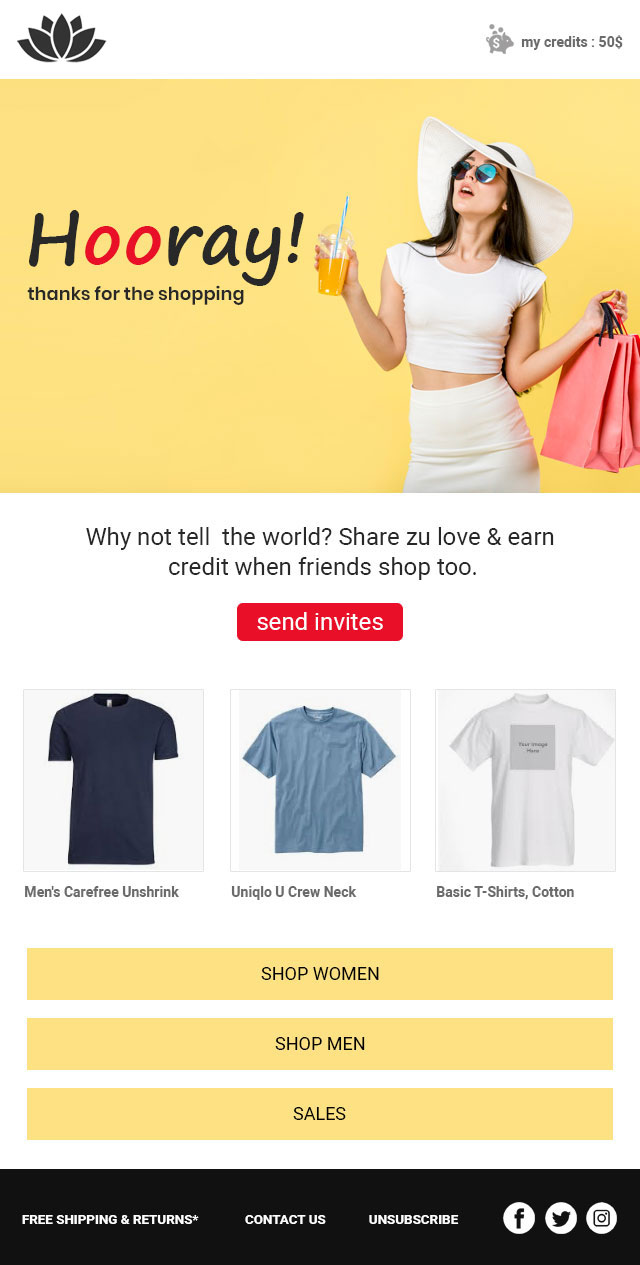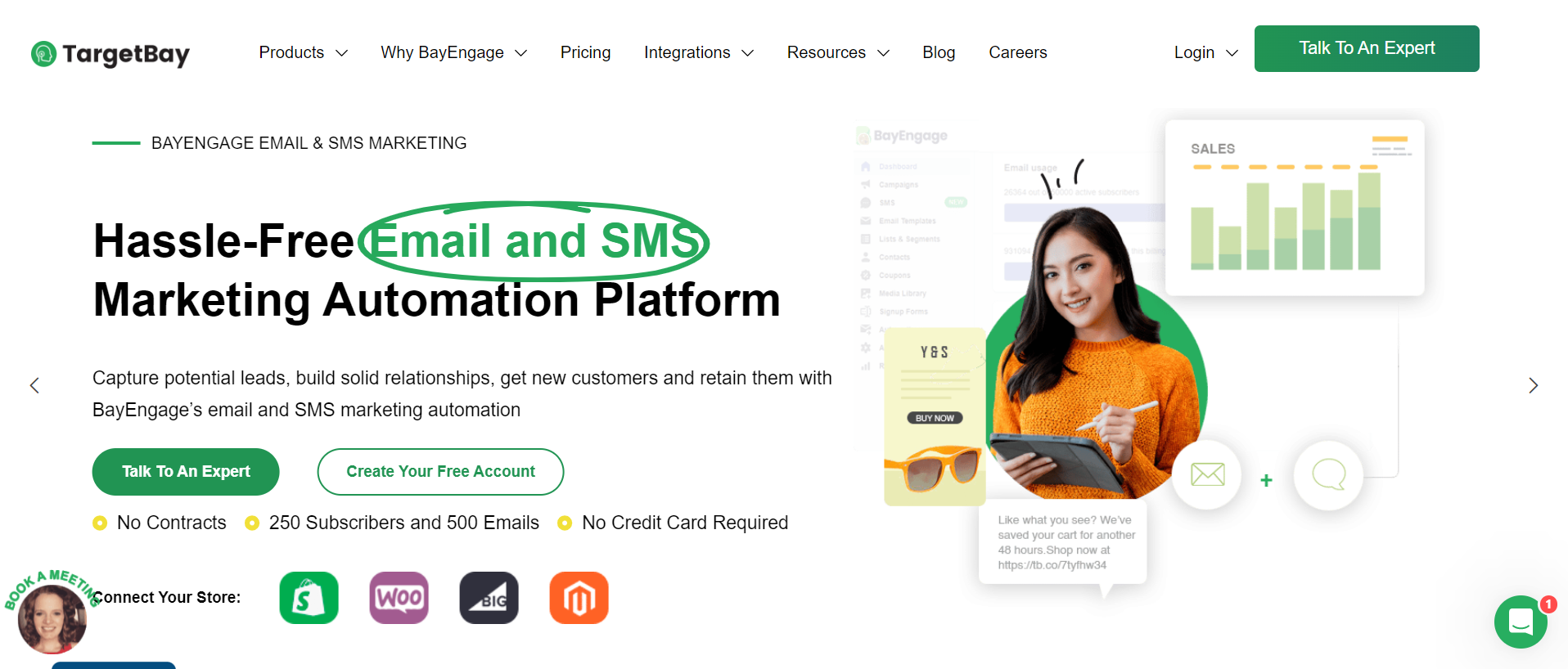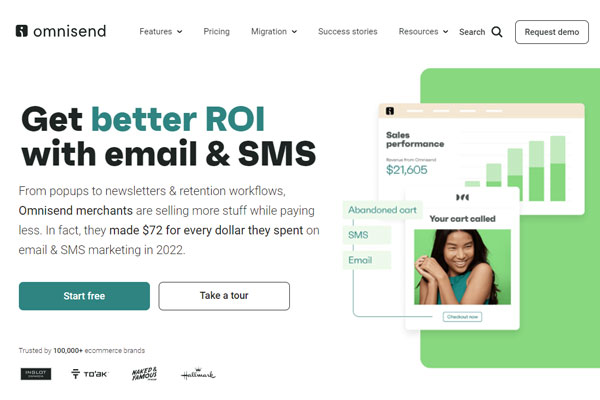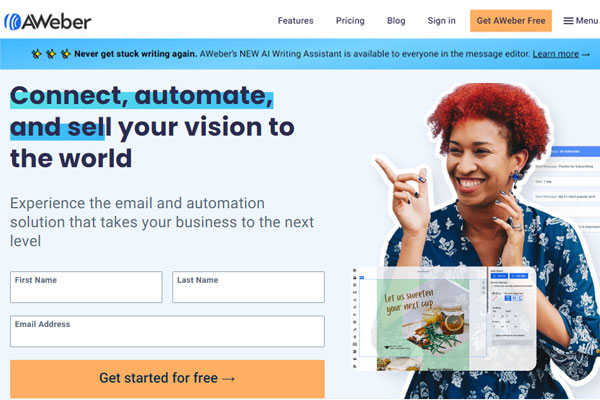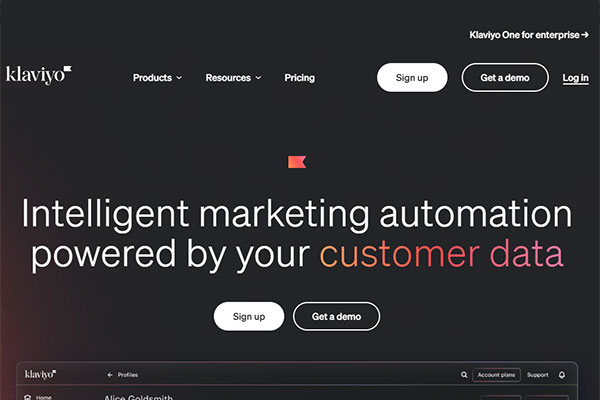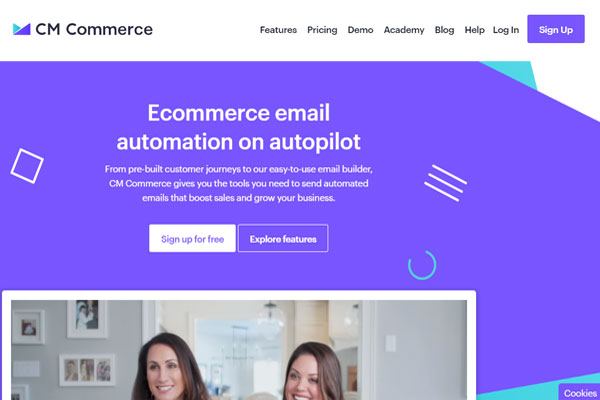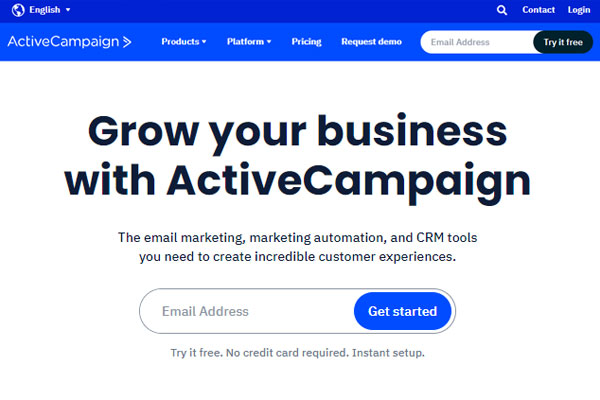Email Marketing has been around forever since the 1970s and the first commercial email was sent in 1978! And since then, email marketing has been one of the best media for marketers to build, nurture their customers, and generate leads. It is all the more vital to give importance to Shopify email marketing.
In 2020, around 306 billion emails were sent and received every day around the world, and in 2025, it is projected to move to 376 billion! Not only that, the overall number of email users is approximately 4 billion, and it is going to grow! Thus, there is so much more potential for Shopify email marketing than one might think!
What is Shopify Email Marketing?
Shopify email marketing is when you choose email marketing as one of your primary channels for marketing through email campaigns. You can start doing this as soon as potential customers that visit your website opt-in to receive communications from your brand via emails.
It is a channel for marketing where you can create awareness and improve customer loyalty by emailing your email lists at regular intervals without spamming them. There are many strategies on how to do Shopify email marketing effectively and efficiently!
This guide will help you know everything about the email marketing platform for Shopify and how you can optimize it towards wholesome Shopify email marketing.
By using this ultimate guide for Shopify email marketing, you will learn how to
Increase your lead generation
Improve your open, click-through, and conversion rates
Send targeted Shopify automated emails and many more!
Are you ready to crack Shopify email marketing? Click the subheading in the Table of Contents to skip to its content!
Why is Shopify Email Marketing Important?
This question is a much-pondered one in the milieu of marketing to the point it has become something self-evident!
Email marketing plays a crucial role if you are a Shopify store owner or any Ecommerce store owner as they are personal, budget-friendly, and direct. That’s it! It is simple. Still thinking it is not that important? Let me explain why it is essential in detail!
It’s Personal
Shopify email marketing allows you to reach anyone directly through their inbox, unlike Social media marketing. It also gives the feeling that the brand is in constant touch with them and that you haven’t forgotten your customer.
Your email could be as simple as “Hey there! Happy Birthday, love! Here’s a coupon code to celebrate your birthday.” It is still seen as a valuable email as your brand remembers its birthday and boosts your brand image and engagement with your audience.
It’s Affordable
Moving on, the next best thing about email marketing is it is affordable. Most email marketing software provides a free trial for up to a specific period. This will not only help you get accustomed to its features, but you can start sending emails right away to increase your reach and ROI. And even after your free trial ends, their pricing is still cheaper compared to other marketing channels!
In addition, email marketing gives you the highest ROI – for every dollar spent on it, you get $ 44 in return!
It’s On Point!
Email is your best bet when it comes to reaching your target audience directly.
How?
It’s because of the highly powerful segmentation features most email marketing software provides. Segmentation helps you to avoid spamming people and allows you to send emails that they actually prefer to get! And that’s why 64% of consumers prefer emails over other communications.
If someone has subscribed to your emails, then it is understood that they want to hear from you. So here’s where you need to optimize your Shopify email marketing strategies and retain your subscribers as much as possible. If you give your subscribers the correct information and incentives, you not only gain their trust, but they will become your brand ambassadors.
It’s Consistent
Social media marketing might sound very trendy and attractive, but it has a high-risk factor. Most social media platforms change their algorithm constantly, this might affect your reach, and sometimes you might lose your followers in a matter of days.
On the other hand, there is no such algorithm for you to worry about with email marketing. And to put it precisely, you are not at the mercy of third-party gatekeepers. It’s your own contact list, and you have the ability to leverage them to your advantage. This makes Shopify email marketing consistent.
It’s Data-driven
Shopify email marketing app gives you access to the data on the performance of your email campaigns. For example, you can see the open rate, click-through rate, conversion rate, and unsubscriber rate.
Make use of these data to improve campaign performance regularly!
For instance, Do you see a less open rate? Work on your email subject lines using A/B testing. Do you see a low click-through rate? Work on personalizing your CTAs. Do you see a low conversion rate? Work on the efficiency of your landing pages. Do you see a high unsubscribe rate? Analyze the frequency of your emails.
The answers are out there, and they are crystal clear, with no room for doubt. It makes things easier for you, and you can work on perfecting your email marketing campaigns!
Install BayEngage For Your Shopify Store
✅ Access 300+ email templates
✅ Recover 64% of abandoned carts
✅ Segment your audience
✅ Automate your emails
✅ Acquire subscribers with pop-ups
✅ A/B test your email campaigns
✅ Simple drag & drop interface
✅ In-built stock asset library
Email Marketing Stats You Should Know!
Before you choose any marketing platform, you should know the existing data around it and then decide which marketing channels would suit your business. To make things for you, here are some vital email marketing statistics that will help you to make up your mind!
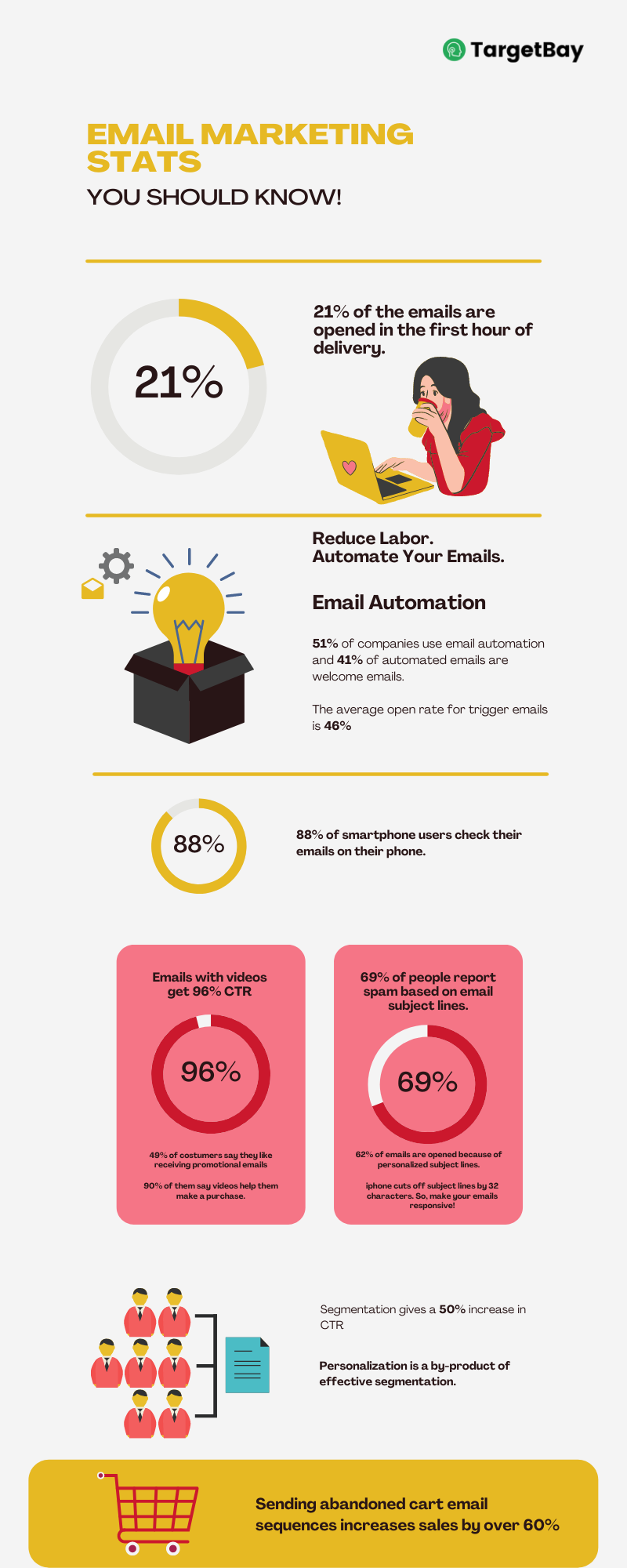
Shopify Email Marketing Challenges
There are some challenges to Shopify email marketing that we want you to be ready for. And again, these challenges are not hard to overcome; you just need to know the right direction to pass these hurdles seamlessly.
So these are some challenges that you might face:
- Low email deliverability rates
- Less open rates
- High spam complaints
- Low click-through rates
- High unsubscribe rates
And now, let’s discuss how to combat these challenges to win the marketing battle!
Improve Email Deliverability Rates
Low email deliverability is caused due to two main reasons: the emails went to the spam folder, or the Internet Service Provider blocked the emails.
Don’t worry. Luckily, there are a couple of ways you can make sure that you can avoid this scenario.
1. Double Opt-in Process
Make sure that you send emails to people who have agreed to be on your email subscribers list. This plays a significant role in your deliverability rate, and you should not take this lightly. Ensure that your email list is full of engaged users.
To do this, follow the double opt-in process!
This is the ideal form of getting people’s consent to sign up for your emails, as it comes with a secondary action from the potential subscriber to confirm their subscription to your emails.
This can be done in many ways: you can use the “click the link to confirm” method or ask them to paste a URL in the browser or even check a reCAPTCHA box after filling out our sign-up form, etc.
2. Send Valuable Emails
Never stress over the Internet Service Provider blocking your emails. Focus on the recipients. Think along the lines of what emails would be considered valuable.
Put your effort into making sure that your email recipients are happy to receive your emails. The ISP will automatically not trouble your deliverability rate as the ISPs’ target is the end user’s comfort!
3. Set an Email Preference Center
Once you get your potential email subscribers’ consent to your emails, the next thing you should do is set up a preference center. There are 3 types: a time-based preference center, a content-based preference center, and a hybrid preference center. These will help you understand how often a subscriber will like to receive your emails; what kind of content they will want to read too!
This is a win-win situation! You get the perfect scenario where you get to understand your subscribers better, and so more targeted emails and your subscribers are happy too!
Improve Email Open Rates
Low open rates are a universal problem, and it proves that your engagement rate is low. The top reasons might be your subject line, preview text, and sender name.
And these can be fixed by A/B testing your emails! Yes, a standard feature of any Shopify email marketing software is the A/B testing feature. It allows you to send emails with varied subject lines, preview text, and sender names to different sets of subscribers.
Later, you get a report on the open rates for the emails and help in understanding which worked and which didn’t- through its precise measurements. See which emails got you higher open rates, and then all you have to do is tailor your emails accordingly!
And another great way to improve your engagement rate is to personalize your emails!
Reduce Spam Complaints
Spam complaints are disastrous to your Shopify email marketing game. They might ruin the brand image that you are toiling to build. And getting 1 spam complaint out of 1000 emails is totally normal, and anything above that is considered high. Usually, a high spam complaint rate results in a lower deliverability rate or even the risk of being blocked by the ISP.
Here are a couple of ways you can reduce this risk:
1. Double Opt-in Process
It helps increase your deliverability rate (as we discussed before), and it also helps reduce spam complaints! This just proves its significance, so leverage this!
Another thing to keep in mind is clear off your contact list every 12 months or, better, ask them to double opt-in once every 6 months. Older contacts in your lists are what lead to high spam complaints.
2. Give the ‘Unsubscribe’ Option
It’s always better to get unsubscribers than get spam complaints. So, never fail to place the ‘unsubscribe’ option in a prominent place to show that the subscribers can opt to unsubscribe anytime they prefer. If you fail to give this, they will be forced to mark your emails as spam.
3. Give a Name to Your Sender Email Address
Never send emails from a ‘noreply@XX.com’ kind of email address. Instead, give a proper name to your email address. This will make it personal and increase brand engagement!
4. Relevancy is Key
Only send relevant and targeted emails; this will not only reduce spam complaints but also increase subscribers’ interest in your content. Your content should be relevant to the audience, and to send the right content to the right people, you need to focus on targeted email segmentation before running Shopify email marketing campaigns.
When you get your audience hooked on your content, there’s no way they will hit the spam button!
Improve Click-Through Rates
Click-through rates measure the effectiveness of your Shopify email marketing campaigns. For example, clicking the CTA tells you that your subscribers are one step closer to converting to your customers. So they are as crucial as any metrics.
To calculate the click-through rate, divide the number of unique clicks by the number of emails delivered and then multiply that number by one hundred to get the percentage.
Here’s how you can improve them:
1. Clear CTAs
The CTA button is the key to an email. It is what completes the purpose of your emails. But, without a clear CTA button, the email funnel will remain stagnant. So, create a compelling Call To Action button that will nudge the customer to click.
The content of the email must be built towards the CTA. And so, the copy in the CTA should be relevant and compelling to your target audience. A perfect CTA should be well-thought-out. It should have the right color, copy, style, size, and style
Most of all, it should resonate with the audience. This cannot be guesswork, so A/B tests your CTAs!
Segment Your Audience with BayEngage
Personalize your emails and 10X your engagement by segmenting your
contacts based on behavioral, transactional, and demographic data
Get It On Shopify
2. Segment, Segment, Segment!
Email segmentation is so crucial to email marketing, and it is what makes emails targeted. However, if you target everyone, then you engage no one. Ultimately, it will only result in failure. So take extra care in segmentation.
Before you send any emails, the first thing you should do is segmentation. Segment your audience and then send your tailored content to each segment. Wait and watch the magic happen!
Email segmentation strategies work! There should be no doubt about it. There are numerous ways you can segment your audience:
- Age
- Gender
- Demographic
- Online behavior
- Purchase history, etc.
When you segment your email lists and send the right email to the right people, the chances of your subscribers clicking that CTA button gets high! Give your subscribers what they want, and you will get high click-through rates.
3. Use Attractive Email Templates Every Time
We can’t stress enough when we say that an attractive email template takes you a long way when it comes to Shopify email marketing. Who wouldn’t like visually appealing emails?
So be creative and innovative with email templates. Use a different template for every email campaign you send. This will pique the interest of your subscribers and nudge them to click the CTA to know more about what your brand offers!
Reduce Unsubscriber Rates
To be honest, unsubscribers are unavoidable. It is bound to happen in Shopify email marketing. Unfortunately, unsubscribing to an email listing is totally subjective, and it is hard to pinpoint what caused it.

Jokes aside, there are some ways to lessen the rate and do some prevention before it happens!
If your unsubscribe rate is below 2%, you have nothing to worry about. If it’s anything higher than that, here are some strategies to overcome that:
1. Be Regular
Stick to a timeline for all your emails. Would you like it if someone promises to meet you at a specific time and ends up reaching there 2 hours late? Apply the same principle here. No one likes an email newsletter that doesn’t follow a timeline. So decide when and how frequently you will be sending those email newsletters, and stick to it!
Let your subscribers know when they sign up for your email list about the timing and frequency of your emails beforehand. This sets expectations and builds trust in your brand.
2. Ask for feedback
It’s normal to believe that once a subscriber is lost, they are lost forever. But that’s not the case.
That’s why Shopify email marketing is convenient. Send them follow-up emails asking for feedback on why they unsubscribed. Some may reply, and some may not. The feedback you get might surprise you, but it will be helpful to you in understanding where you need to improve.
Groove chose to send a request feedback email instead of a survey, and the results were multitudes higher than expected. Here’s their requested feedback email:
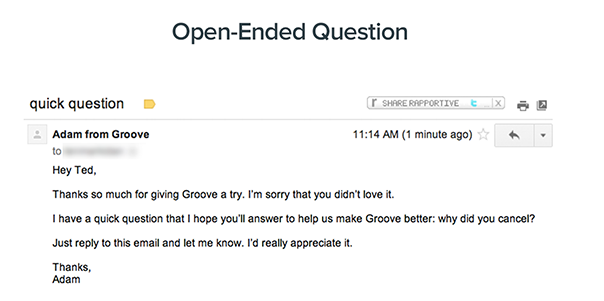
This is a simple email, yet somehow very personal. This allows the brand to come across as thoughtful and caring.
Ah, now that we have discussed all the possible challenges you might face in Shopify email marketing and how to combat them, let’s move on to optimizing your email marketing!
How to Optimize Email Marketing for Your Shopify Store
Before we move on to what kind of emails to send and what features you need in email marketing software, let’s take a step back and look at how to make your emails targeted and make them converting assets for your Shopify store!
Subject Lines
Subject lines are the first thing that gets noticed by your potential customers before they even open your emails. And they are key players in deciding your open rate.

And when subject lines fail, your Shopify email marketing campaigns are sure to fail. So put your everything in it! Then, go the extra mile to create the perfect subject line for your emails!
Email subject lines are more important than ever as inboxes get filled with hundreds of emails every day, and nobody has the time to open every email to check whether the content is valuable or not.
So, hook your audience with an intriguing subject line. Avoid cliches at all times; nobody likes a copycat. No matter how sophisticated your emails are, it doesn’t matter if your emails are not opened.
Quick tips for engaging subject lines
✅ Keep your subject lines short to avoid getting cut down. Also, keep it under 5 to 7 words, as oftentimes, people tend to check emails using their smartphones
✅ Avoid spammy subject lines. And by this, avoid the overuse of exclamation points, avoid cliches, don’t use all caps, and never be aggressively salesy with your subject lines. This will directly result in an unsubscription or, worse, a spam complaint!
✅ Ask open-ended questions. They intrigue the audience and focus their attention on the email. They might want to know the answer to the question you ask in the subject line, and this curiosity will nudge them to open the email!
✅ Always A/B test your subject lines! We have discussed the importance of a subject line enough, and A/B testing is a surefire way to find which subject lines give you higher open rates, and you can follow the tone and style of that winning copy for your future email campaigns!
The power of the FOMO element in your
subject line❗
Make use of FOMO in your subject line. The Fear Of Missing Out on things works wonders! Send a series of emails when you inform them about a product recommendation, a deal, or an offer code, and a ‘now or never’ or a ‘Don’t miss out on this deal!’ always creates a sense of urgency among your target audience and they will more likely open the email. But make sure always to offer what you promise in your subject line!
Here are some great email subject lines to boost open rates!
A/B testing
I know I sound like a broken record by asking you to A/B test this or A/B test that and how it is essential. But hear me out some more, as this A/B testing deserves more credit than this!

If you don’t practice the A/B test, it’s about time you do. If Batman can’t convince you, I don’t know who can?! But let me try anyway!
A/B testing is a great way to improve your open rate and click-through rate. A/B tests everything about your email, starting from subject lines to CTAs. A thorough split testing will always give you the answers you are looking for!
Small changes in your content make a huge difference in the performance of your Shopify email marketing campaigns. And it might increase your engagement rate and revenue, and the only way to achieve a better version of your emails is through A/B testing.
What should you test?
- Email subject lines
- Length of your subject lines
- CTAs
- Email templates
- Content
- Visuals
- Emails with and without images
- Personalization of your emails
Quick tips
✅ Hypothesize before you A/B test anything! This will help you visualize why A/B testing a particular aspect of your email will increase your open or click-through rate.
✅ Not all A/B tests will yield positive results. Some might work, and some might fail. The trick is to learn from your mistakes, and that’s the objective of doing this process. In addition, it helps you understand the nuances of email marketing and your target audience.
✅ Learn to prioritize which element of your email you want to run A/B testing first. And deprioritize others by hypothesizing, which is not important at that moment.
Make Your Emails Mobile-Friendly
Mobile-friendly emails ensure a good user experience. And did you know that 68% of emails are opened on mobile devices? And so it’s mandatory if you want better reach. No one wants to take the effort to zoom in and out of their screens just to read your content. So it is up to you to make it easier for them to improve engagement.
Starting from your email templates, subject lines, email content, the preview text, and everything else you might have in your email should be mobile-friendly. Or else be ready to lose out on more than 50% of your CTR.
Here are some challenges emails face when it is viewed on a mobile device:
- Images get turned off as default if it’s not mobile responsive
- Each mobile model might have varied support for responsive design.
These things happen as they are different from the needs of a desktop/laptop user. And this is why you need to make your emails mobile-friendly from the get-go!
Quick tips for better email content
✅ While creating content for your emails, keep your content short. Be it the subject line or the preview text, or the body of the email. Give the gist of your content, as most smartphone users read emails on the run. So make it easily scannable!
✅ Consider using dynamic content which looks good on all the devices
✅ Know your audience. Most email marketing software gives you data on the devices your subscribers use. Create a persona to understand your target audience and their habits better before you start sending your Shopify email marketing
Quick tips for top-notch email design
✅Use a single-column email template layout as that is easier to view on a smartphone considering its size
✅ Place important info or CTA on the left side of your email template
✅ Avoid attaching large-sized digital assets to your emails. Most of the time, the data connectivity and the downloading speed might be low on smartphones
✅ The CTA button should be clearly visible and touch-friendly
✅ Cut out any design element that doesn’t fit your brand identity. Keep the design simple
✅ Use responsive email designs. It helps in responding to the real-time size of the device’s screen
The Best Time To Send Emails
There is a correct timing to do any activity, and the same goes for your Shopify email marketing campaigns! You should know the right time to send your emails to increase your reach and visibility.

Every email marketer swears by this, the best time to send emails: is Thursdays from 8 am to 9 am, and the worst time: is Tuesdays and Wednesdays from 8 a.m. to 10 am.
And the timing differs on which device the subscribers are using. For example, a desktop user is usually active from morning till mid-day, and mobile users are active in the evening too.
And understanding your demographics is the most vital factor you’ll do for your email marketing success. They’re your audience – you need to understand their habits and cater to them.
An instance where they override the safe “best time to send” general advice:
If you’re targeting the young, tech-savvy crowd, ignore the overall tip concerning not sending emails in the dead of night. Evening emails may work simply fine for younger audiences.
And don’t forget to think about your target demographics’ zone – you actually need to customize email send times depending on wherever your recipients live.
So the answer to “When is the best time to send emails?” – Depends on your audience.
I know this answer doesn’t solve anything. But you can always find it through trial and error by sending test emails. This way, you will get to know which time YOUR target audience is active!
Read this to learn more about the best time to send emails!
How To Find The Right Email Marketing Software For Your Shopify Store
If you are someone who owns a Shopify store, you might have searched on the Shopify website for the best Shopify email marketing app. And that would have given you more than 500 in the results.
But how can you decide on one that has the features you need?
Let’s take a look at some of the must-have features of Shopify email marketing software!
Inbox Deliverability
What’s the point of sending your email campaigns if it doesn’t get delivered to the inbox but the spam box? You will just end up wasting your time, energy, and money! So the first thing you need in a Shopify email marketing app is high inbox deliverability!
You need to give your emails a chance to be even seen by the recipient; only then can you start thinking about open, CTR, and other metrics!
A/B Testing feature

Again, this is the fourth time we are talking about A/B testing. Again, let me reiterate it, YOU NEED IT!!
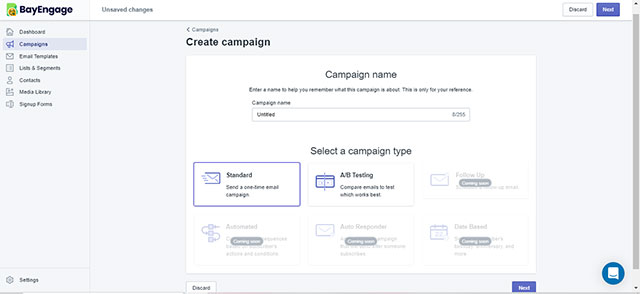
Responsive Email Templates
You don’t need just any email templates; you need responsive ones with the drag-and-drop editor. This will make things easier on your end. And there won’t be any need to worry about mobile responsiveness or about editing them.

Powerful Lists And Segmentation Feature
You should be able to import your contact list directly to the app without any difficulties. Then, the app can segment your lists into different categories automatically.
This way, you can send highly targeted emails and ultimately increase your conversion rate and ROI!

Insights
The Shopify email marketing app should give you all the necessary and key metrics that you will need to improve your email campaigns: open rate, click-through rate, new subscriber rate, unsubscribe rate, etc.

These are the most basic and crucial features you need in a Shopify email marketing app to take your email marketing game to the next level!
Let’s move on to the next must-know thing about Shopify email marketing!
How to Build Your Shopify Email List
If you want to be successful with Shopify email marketing, you must first be successful with building your email list.
After all, you’ll need some subscribers before you can start sending emails.
So, how can you persuade folks to subscribe to your emails?
Here are a couple of ways:
1. Exit-Intent Pop-Ups
We’ve all experienced pop-ups that appear on our screens as soon as we visit a website. Exit pop-ups are a less intrusive approach to promoting your email list, as it targets people who leave the website without purchasing anything.
However, its intent is clear, and most of the time, it succeeds in grabbing the attention of the leaving page visitor!
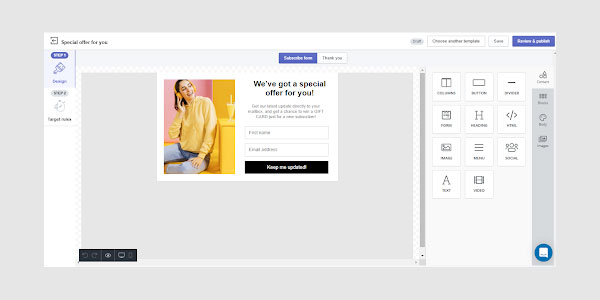
This method is a great way to pull your visitors’ attention back to your website and turn them into valuable email subscribers by employing this form of Shopify email capture.
1. Add An Opt-In Bar to Your Homepage
While pop-ups are useful, simply placing an opt-in email form on your homepage might help entice users to sign up for your email campaigns!
Likewise, place one opt-in form at the bottom of your page as well as the page’s foot! Again, this will be visible as the visitor scrolls through the page.
2. Create A Landing Page for Sign-up Forms
Landing pages provide a strong motivation for people to sign up for your email list and give you a little more room to talk about your product or explain the benefits of subscribing to the email list.
Social proof should be included on an email landing page to build credibility. This can be a testimonial, a star rating for your product, or even just a brief about how many people have signed up for your email list.
For example, you could link to your email capture landing page as part of your email signature or advertise it on social media. People may go straight to the signup page and subscribe to your emails when you add the link.
3. Run A Contest and Announce A Giveaway!
A contest is an excellent technique to persuade people to give you their email addresses. Contests also have the added benefit of being extremely shareable, which means that people will promote your Shopify store to their friends and family on your behalf.
And it’s the quickest way to build your email list; all you have to do is make it intriguing and fun to be a part of!
And also, to organize a contest to grow your email list:
- Make the prize worth their attention
- Include social media sharing buttons.
- Create a theme that will appeal to your target market.
- Include a countdown to create a sense of urgency.
- Keep track of the results.
4. Give Them What They Want!
It is not necessary for the incentive for joining the email list to be directly tied to a transaction.
Your audience may be unclear about what they want to buy at times: they may be aware of an issue at the awareness stage but unsure of how to address it.
It’s your responsibility to discover what kind of challenges your audience is now encountering. Then you may create material that assists them in resolving their issues while also directing them to your items, which can be hosted on a content hub on your website.
This type of content can be a strong incentive for people to join your email list. It also increases trust in your brand as a subject matter expert.
Apart from all these ways, the best way to do this is by using an email marketing agency.
There are many different agencies, and some are better than others when offering their services. If you want to find one that will work with your budget and schedule, you should ensure they have a good reputation.
And that’s how you steadily build your Shopify email listing!
Types of Shopify Email Campaigns to Send (with Examples)
1. Welcome Emails
The best way to engage new email subscribers is by sending them an automated “welcome email” as soon as they sign up. Welcome emails set the tone and the nature of your email throughout your communication cycle with the subscriber, and so you need to give it utmost importance!
If you don’t send welcome letters to new subscribers, you’re ignoring them — and leaving a lot of money on the table.
Shopify welcome emails should also establish expectations for your email communication techniques. For example, what kinds of emails are you planning to send? What’s the frequency with which you’ll send them?
These clarifications can not only get subscribers excited about what’s to come, but they may also keep them from being startled by your content later on, which can lead to spam complaints and unsubscribes.
Take a look at this example Shopify welcome email template that you will love!
2. Order Confirmation Emails
Order confirmation emails, like other automated messages like welcome emails, thank you emails, or confirmation emails, are not merely a formality to tell your consumers about the transaction. It’s also a terrific way to establish a rapport with your customers.
And personalization is an excellent way to make your Shopify order confirmation email appear sincere to your customers!
Here’s a Shopify order confirmation email template as an example!
3. Abandoned Cart Emails
Shopify abandoned cart email allows you to re-engage, converse, and create relationships with cart abandoners who leave without completing the purchase. There are many reasons for Shopify cart abandonment.
60+ Abandoned Cart Email Templates
Waiting for You
Pick a template, customize it, and set up an Abandoned cart workflow!
Get It On Shopify
With customized emails and personalized product recommendations, you can make your customer communications more relevant and valuable, and your brand will appear more relevant and helpful to them.
The most apparent benefit (and the primary motivation for employing this method) is increased revenue and conversion rates.
To begin with, sending Shopify automated emails rather than manual ones allows you to save time and money while also increasing efficiency.
Read this to know more about the Shopify abandoned cart apps.
Here’s an example of Shopify’s abandoned cart email template:
4. Newsletter Emails
Shopify newsletters are often the life force of your marketing campaign. The goal of an email newsletter is to keep your subscribers up to date about your company, goods, and services. It’s not, however, something that’s commonly employed in a complex sale.
Instead of sounding like a pushy salesperson, interactive newsletters should feel like an update from an intriguing, helpful friend.
Learn more about how to create and send Shopify newsletters here!
5. Win-Back Emails
The goal of a Shopify win-back email campaign is to re-engage inactive subscribers. The goal is to attract their attention and persuade them to answer so you can verify that they are still getting your mail and are interested in your products or services.
Many of your list’s subscribers have likely been idle and unresponsive to your email campaigns for months. They haven’t unsubscribed, but they are either choosing to ignore or not see your messages.
The issue isn’t just that those subscribers aren’t getting the benefits from your emails; their inactivity is also lowering your open and click-through rates. This informs spam filters and other email delivery system components that your email may be unsuitable, potentially lowering your email delivery rate even further. And that’s why you send out win-back emails to rekindle your relationship with your subscribers.
Check out this example Shopify win-back email template!
6. Re-Engagement Campaign
Re-engagement emails are sent to customers who have not purchased from you in a while but may be interested in returning to your store. These can be sent to customers who have made a purchase in the past and those who haven’t. It’s important that these emails are personalized and relevant to each customer based on their purchase history, so you should use automated email campaign tools that allow you to do this.
Send Re-Engagement Emails
If someone hasn’t bought anything from you recently (or ever), it’s likely they’re not ready yet. You could send them an email asking why they haven’t bought anything or offering some discounts or free shipping if they make a purchase within a certain time period—something like 10% off all jewelry purchases made by midnight tonight!
7. Shipping Confirmation Email
When you send your customers a shipping confirmation email, it should include the following:
- Tracking number. This is the most important information that customers want to see in a shipping confirmation email. It’s also a great opportunity to upsell them on other products or services you have available.
- Estimated delivery date and time (if applicable). Your customer will want to know when they can expect their package, so make sure that you provide this information clearly in your shipping confirmation message.
- A link to your return policy page (if applicable). Make sure that customers understand how long they have before they can make returns and refunds by providing links directly from within the shipping confirmation email itself!
- An email address where customers can contact you if there are any problems with their order or if it hasn’t arrived yet by the estimated delivery date and time provided earlier on.
8. Follow Up Email for Unhappy Customers
Here’s why it’s important to follow up with unhappy customers:
- You want them to know you care.
- You want to learn what they didn’t like about the interaction so you can improve future customer experiences.
Here’s how to follow up:
- Set a reminder for yourself in your calendar or planner that you need to draft the email within one week of receiving the customer’s feedback. This way, you have time to think through all of the details before writing it out (but don’t wait any longer than that).
9. Post Purchase Product Review Request Email
This email is a great way to get reviews.
There are two parts to this process:
- Send an email asking for a review of your product.
- Appoint someone (or everyone) in your team as the reviewer manager, who will be responsible for sending out review requests. This person should be able to add products from Shopify’s stock database and send out reviews on their own.
Automate your Email Marketing to help Increase Sales.
Automated email campaigns are a great way to increase sales. They help you build relationships with your customers and keep them coming back for more of what you’re selling. The more automated, the better—and the less time you have to spend on things that aren’t directly related to your store’s bottom line.
By automating certain processes in your business, you can free yourself up to focus on other areas that need attention. This allows for more efficient use of everyone’s time and resources (including yours).
Automated email campaigns can be a great way to keep your customers engaged with your brand. These are just some of the automated emails you should set up for your Shopify store, but there are plenty of other opportunities as well. Remember that you never want to overwhelm or annoy your audience with too many messages, so make sure you’re only sending relevant and valuable content in each campaign.
10. Back In-Stock Emails
For a variety of reasons, including increasing seasonal demand, products may become out-of-stock. Customers who expect to be able to buy what they want when they want it may be frustrated by the result.
Out-of-stock has consequences that go beyond the actual loss of a transaction. To begin with, there’s a chance that the customer will go to a competitor to find the desired goods.
Shopify back-in-stock emails alert the customers who have looked at out-of-stock items that are now available. They work similarly to price drop emails. Customers’ browsing history can be used to send an automated email when a product is replenished. Customers will be relieved that they did not lose out on their preferred item, and they will feel certain that your store is the finest place to find it.
Here’s a great example of a Shopify back-in-stock email template!
These are some of the must-have automated emails for your Shopify store!
Now that you have learned all the fundamentals of Shopify email marketing, and if you are looking for the right email marketing software, check BayEngage!
What’s Next?
One of the best things about email marketing is its low-risk factors. That is why the overall number of email users is approximately 4 billion, and it will grow! And the possibilities are endless to learn more about its nuances to become an expert in the field. We at TargetBay, have prepared a list of other blogs to help you continue your thirst for knowledge to improve your email marketing expertise! So keep learning and ace every one of your Shopify emails!
List of Shopify Email Marketing App Providers You Should Consider:
1. BayEngage
BayEngage is an easy-to-use email marketing software that is created for small to medium businesses. Its clients are mostly Ecommerce stores, and it has integrations with many Ecommerce platforms like Shopify. It is the perfect email marketing solution for Shopify.
2. Shopify Email
ShopifyEmail is an email marketing software created by Shopify itself. And it is a fairly new app that was launched to replace Mailchimp when Mailchimp was taken off from the Shopify platform. Although it is new and basic, it still is one of the best Shopify email marketing tools.
3. Omnisend
Omnisend is an all-in-one marketing platform. It has seven different marketing channels: Email, SMS, Facebook, Google customer match, Facebook Messenger, WhatsApp, and Shopify email notifications. It also provides email marketing services.
4. Moosend
Moosend is one of the most powerful email marketing solutions for Shopify. Shopify store owners can directly integrate with Moosend with a single click. It is clearly one of the best Shopify Email marketing software in the market, with its email analytics, lists, and segmentation.
5. AWeber
AWeber was founded in 1998 and is clearly one of the leaders when it comes to Shopify email marketing. Their clients are mostly small businesses, and if you are a Shopify store owner, it is the ideal email marketing solution for Shopify.
6. Brevo
Brevo started out as a digital marketing agency but is one of the sought-after email marketing and landing page providers. It is well-known for its email template library, a/b testing, and segmentation.
7. Klaviyo
Klaviyo has become the next Mailchimp and is clearly one of the big shots in email marketing platforms. Klaviyo is known for its sign-up forms, personalization, integrations, insights, and segmentation.
8. Privy
Privy has three major products: Privy Convert, Privy Email, and Privy SMS. It is known for its post-purchase emails, SMS marketing, drag-and-drop editor, and data analytics. It stands as one of the best alternatives for most Shopify email marketing platforms.
9. CM Commerce
CM Commerce is an email marketing tool known for its powerful integration with various Ecommerce platforms. It boasts of its personalized content and seamless integration with Shopify. So send targeted emails with personalized content to your Shopify customers.
10. ActiveCampaign
ActiveCampaign was founded in 2003. It mostly helps small and medium businesses. ActiveCampaign offers more than just email marketing tools to Shopify store owners. It has SMS marketing, paid advertising, and many more.
11. Sendx
Sendx is an affordable email marketing software that won many awards for its customer satisfaction. Like ActiveCampaign, it also does more than just email marketing. It has SMS marketing, advertising, web forms, web page builder, and many more.
Wish to read more and do your research on Shopify email marketing apps? Click here!
FAQ’s
1. What is the best email marketing app for Shopify?
Of course, it’s BayEngage! It has everything you need in email marketing software, and it’s surprisingly affordable for all the features it offers!
2. How to create and send Shopify email newsletters?
Shopify email newsletters are crucial for your business. It helps you with customer engagement and satisfaction. So read this and become an expert!
3. How to create attractive welcome emails, and why is it important?
Welcome emails get more open rates than any other trigger emails, and you need to make use of that to place a strong foundation for a good relationship with your customers. Read this blog to know more!
4. How to build a full-proof Shopify abandoned cart email strategy that converts?
When it comes to Shopify abandoned cart emails, there is no single strategy to win the game; you need to consider the time, content, template, and online behavior of the customers and many more! So check out this detailed account on different strategies you can use to get back your customers!
5. Is there a better email app for a Shopify store than Mailchimp?
Mailchimp has become too mainstream, and there are many Mailchimp competitors who can be your best bet as a Mailchimp alternative! We have done in-depth research on each of the Mailchimp alternatives and published it just for you!









